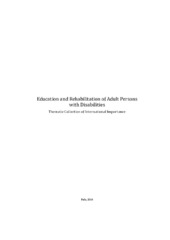Приказ основних података о документу
Paralinguistic aspects of pragmatic abilities in adults with intellectual disability
| dc.contributor | Kulić Milan | |
| dc.contributor | Ilić–Stošović Danijela | |
| dc.creator | Đorđević, Mirjana | |
| dc.creator | Glumbić, Nenad | |
| dc.creator | Brojčin, Branislav | |
| dc.date.accessioned | 2021-06-17T13:06:56Z | |
| dc.date.available | 2021-06-17T13:06:56Z | |
| dc.date.issued | 2014 | |
| dc.identifier.isbn | 978-99955-733-9-3 | |
| dc.identifier.isbn | 978-99955-733-9-3 | |
| dc.identifier.uri | http://rfasper.fasper.bg.ac.rs/handle/123456789/2239 | |
| dc.description.abstract | Many of the authors agree with the statement that the facial expression and prosodic acoustic characteristics together represent the paralinguistic characteristics of communication and that they provide an answer to the question „How something is said?“ Some of the functions of paralinguistic elements of communication include the ability to make a conclusion about the speaker’s attitude or his emotional reactions, identifying personal characteristics of the speaker, concluding about their demographic characteristics, the ability to use paralinguistic signs as signals for the regenerative response and synchronization of conversation as well. The aim of this paper is to isolate and analyze research which as their focus had an assessment of paralinguistic elements in adults with intellectual disability by reviewing the available literature. By searching electronic databases, the papers in which the issue of the ability to recognize and interpret paralinguistic characteristics of persons with intellectual disabilities were collected and analyzed. By reviewing analyzed papers, it could be seen that the issue of the ability of understanding and interpretation of paralinguistic aspects of communication is more often studied in a population of adults with intellectual disability and syndromic specifics, than in the population of persons with intellectual disability syndromes without syndromic manifestations. Presented results of the researches show that adults with Down and Williams syndrome, as well as persons with intellectual disabilities have emphasized difficulties in detecting negative emotion in tasks of facial and vocal expression. Despite many functions of paralinguistic segments of communication, it was observed that in the population of adults with intellectual disability the most often investigated ability was the one to recognize emotional reactions with the help of facial and prosodic expression. Also, it could be concluded that, in the papers in which the ability to recognize facial and prosodic emotions was evaluated, the ability to correlate these constructs significant for pragmatic competence, such as the ability of theory of mind, social competence, ability to recognize irony and deception in testimony etc. was missing. | |
| dc.language | en | |
| dc.publisher | University of East Sarajevo, Faculty of Medicine; University of Belgrade – Faculty of Special Education and Rehabilitation | |
| dc.relation | info:eu-repo/grantAgreement/MESTD/Basic Research (BR or ON)/179017/RS// | |
| dc.rights | openAccess | |
| dc.rights.uri | https://creativecommons.org/licenses/by-sa/4.0/ | |
| dc.source | Thematic Collection of International Importance- „Education and Rehabilitation of Adult Persons with Disabilities “, Foča, Bosna I Hercegovina, 2014. | |
| dc.subject | emotional prosody | |
| dc.subject | facial expression | |
| dc.subject | syndromic specifics | |
| dc.title | Paralinguistic aspects of pragmatic abilities in adults with intellectual disability | en |
| dc.type | conferenceObject | |
| dc.rights.license | BY-SA | |
| dc.citation.epage | 123 | |
| dc.citation.other | http://www.vbs.rs/scripts/cobiss?id=1100481174298092 | |
| dc.citation.rank | M14 | |
| dc.citation.spage | 111 | |
| dc.identifier.fulltext | http://rfasper.fasper.bg.ac.rs/bitstream/id/6753/umhgjfgfhrc.pdf | |
| dc.identifier.rcub | https://hdl.handle.net/21.15107/rcub_rfasper_2239 | |
| dc.type.version | publishedVersion |


